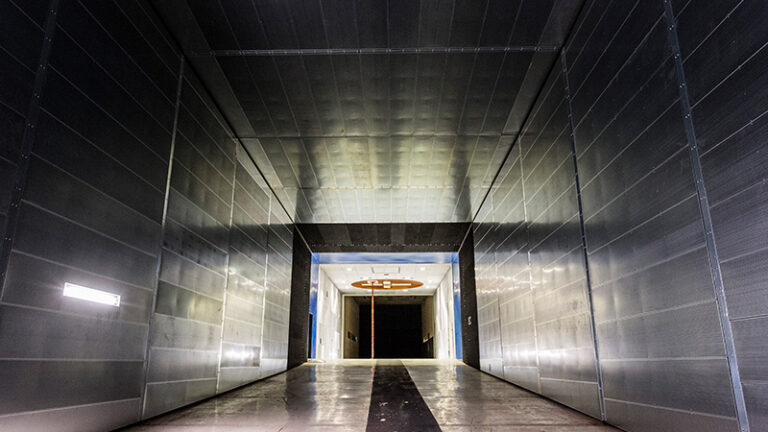Stay Up to Date
Submit your email address to receive the latest industry and Aerospace America news.
The Ground Testing Technical Committee focuses on evaluating aircraft, launch vehicles, spacecraft, structures, and engines in wind tunnels and other facilities.
Ground testing in 2017 was full of wind tunnel upgrades, calibrations and a return to supersonic aircraft design.
Lockheed Martin, in partnership with General Motors, completed a six-month, $12 million renovation of Lockheed Martin’s Low Speed Wind Tunnel in Marietta, Georgia. The renovations replaced the 1960s-era marine plywood tunnel walls with modern perforated stainless steel panels and two sets of acoustically dampened turning vanes. The new walls and vanes in the 16-by-23-foot (4.8-by-7-meter) test section provide a quieter environment. The overall sound pressure levels were predicted to go down by 13.6 decibels (acoustic) — 81.8 dbA at 70 mph reduced to 68.2 dbA. However, the improvement appears to be larger. Data is still being analyzed.
“We have been told that we now have the quietest closed test section wind tunnel in the world,” said Joe Patrick, wind tunnel director. “As we start our sixth decade of testing, we essentially have a brand new wind tunnel.”
Internationally, the 22.5 megawatt main drive motor in the Japan Aerospace Exploration Agency’s 2-by-2-meter transonic wind tunnel was first tested in May. The final shakedown test of the wind tunnel was conducted in September. The motor had been removed in June 2016 and replaced in October 2016. The wind tunnel was built in 1960. This was the motor’s second replacement; the first was in 1987. The length of the new motor requires less space and the motor weighs less at 100 tons. Four parallel inverter drives with an insulated-gate bipolar transistor power the motor. The wind tunnel update also included new controls. Originally, JAXA employees operated the tunnels’ five major components. The upgraded tunnel is more efficient, and a single operator can fully control it.
Northrop Grumman Corp. contracted Calspan’s Force Measurement Systems, or FMS, to support the recalibration of a load cell array to measure the aerodynamic forces on a test assembly at the National Full-Scale Aerodynamics Complex at NASA’s Ames Research Center at Moffett Field, California. FMS designed hardware to supplement the loadings, expanding the number of possible load combinations and more closely mimic the testing environment of the wind tunnel. The six-load cell array was manually calibrated over two weeks at the end of March, resulting in a three-force, three-moment multicomponent balance characterization of the system, providing increased accuracy beyond the original equipment manufacturer calibration.
NASA’s Langley Research Center in Virginia developed and refined calibration techniques with continued work on the design of new calibration hardware. The In Situ Load System, or ILS, provided multicomponent check loads to a rotorcraft model to alleviate concerns regarding the performance of a force balance used for the rotor system loads. Several sets of check loads were conducted in 2017 to verify the balance performance while considering the full model system. This demonstration was the first time the ILS was integrated into a production test model and will help merge the concept into other facilities.
Supersonic passenger airplanes are another step closer to re-emerging. In May, NASA’s Glenn Research Center in Ohio completed the first high-speed wind tunnel tests on the preliminary design of Lockheed Martin’s Quiet Supersonic Technology X-Plane, or QueSST. Testing ranged from Mach 0.25 to Mach 1.6, leading an effort to separate the shocks and expansions associated with supersonic flight to dramatically reduce the aircraft’s loudness on the ground. The QueSST design is one of a series of X-planes envisioned in NASA’s New Aviation Horizons initiative, which aims to reduce fuel use, emissions and noise through innovations in aircraft design.
Editor’s note: Ryan Kew works for Calspan.
Contributor: James Sizemore
Related Posts
Stay Up to Date
Submit your email address to receive the latest industry and Aerospace America news.




